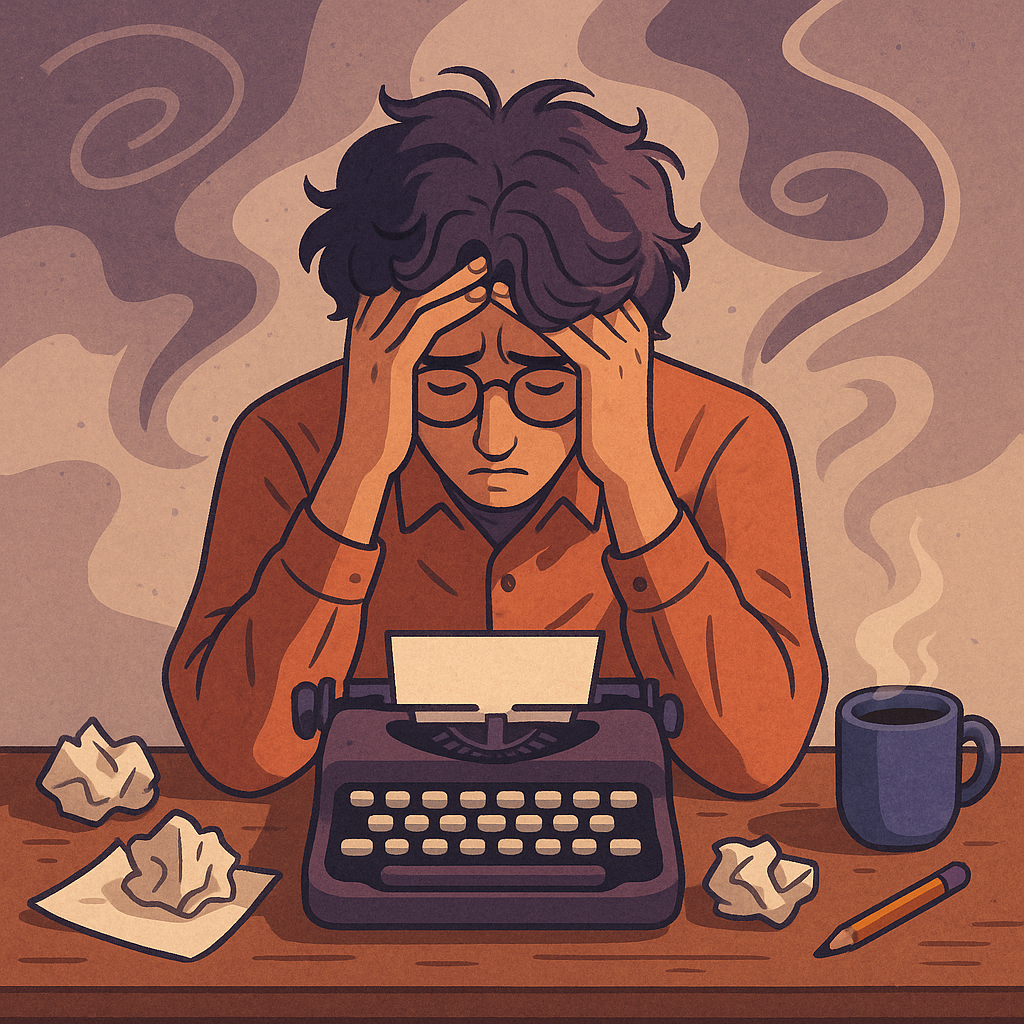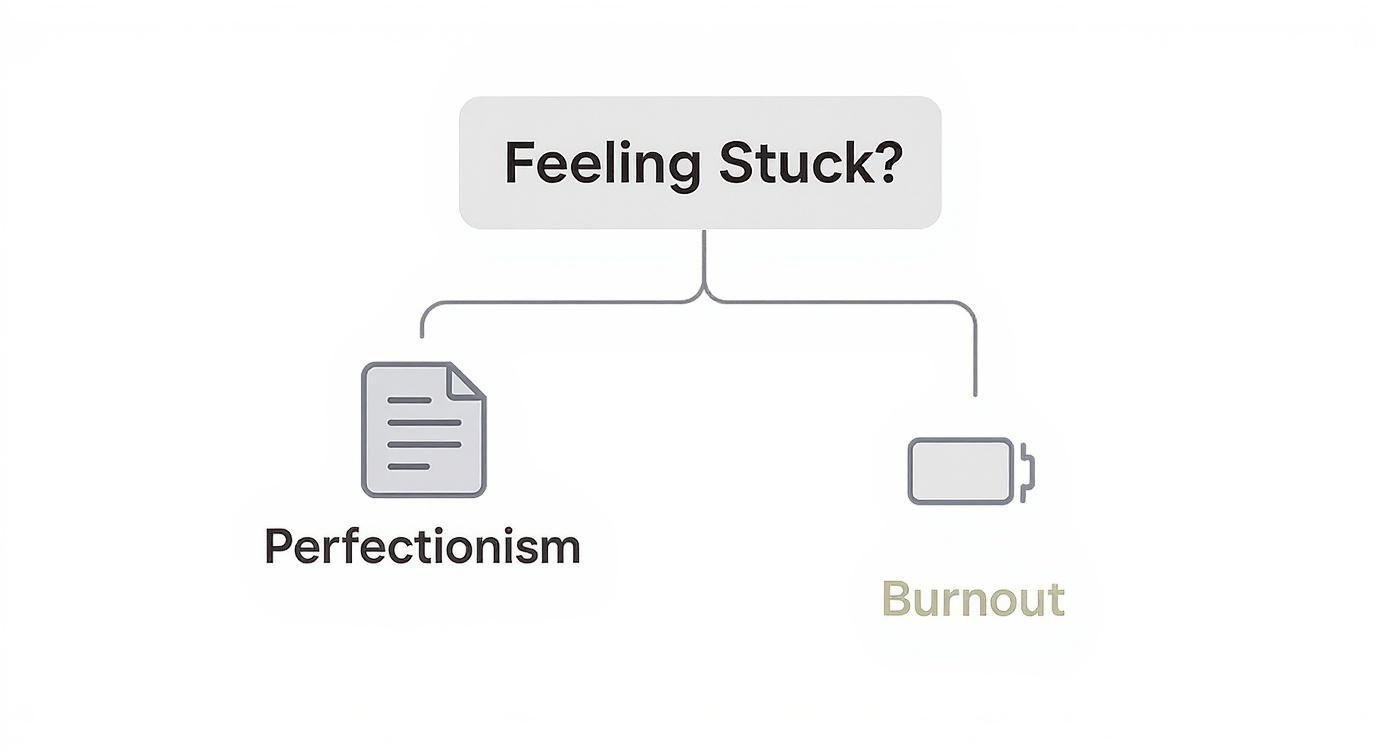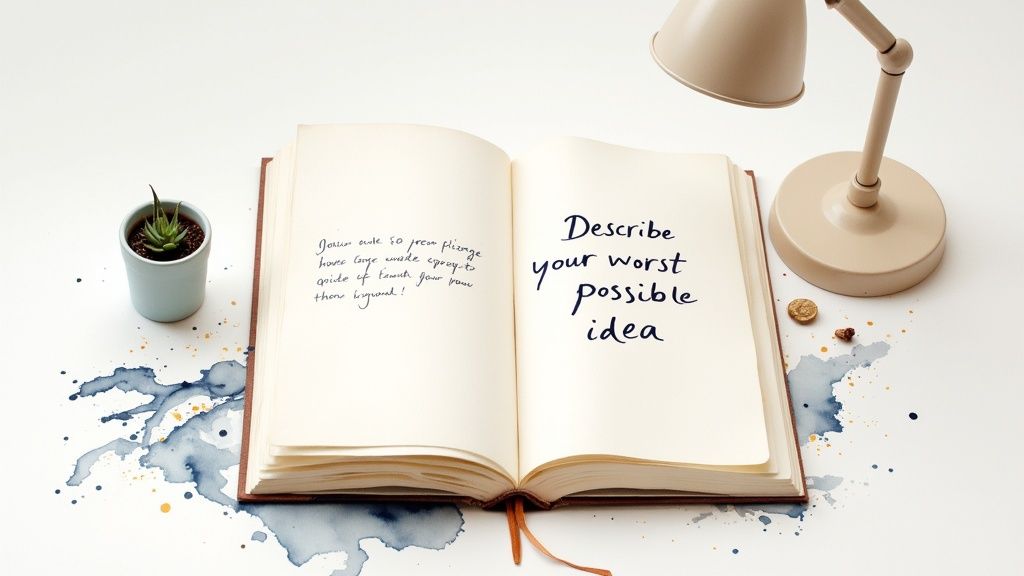How to Overcome Writer's Block: 7 Actionable Strategies
Discover how to overcome writer's block with actionable strategies and proven exercises. Turn the blank page into your creative breakthrough today.

Staring at a blinking cursor, feeling the pressure mount with every silent pulse? You're not alone. Writer's block is a universal challenge, but it's not an unbeatable one. This guide will provide actionable strategies, grounded in my experience as a cognitive psychologist, to dismantle the block and rediscover your creative flow.
The first step is often the simplest: give yourself permission to write badly. The primary obstacle isn't a lack of ideas—it's the crippling pressure to be brilliant from the very first word. By lowering the stakes, you can bypass your inner critic and get moving again.
So, What's Really Causing Your Writer's Block?
Writer's block isn't some mystical curse or a sign you've lost your touch. It’s a signal from your brain. Think of it less like a giant wall and more like a traffic jam—a messy intersection of perfectionism, fear, and creative fatigue.
When you feel stuck, you aren't empty. You're overwhelmed.
Getting a handle on what's really going on under the hood is the only way to dismantle the block and get moving again. These triggers usually team up, creating a frustrating loop that feels impossible to escape.
If you're looking for a deep dive, there are some really solid strategies to get rid of writer's block out there that can arm you with a much bigger toolkit. Understanding the why is everything.
The Perfectionism Trap
Perfectionism is writer's block's best friend. It's that nagging voice in your head whispering that every single sentence has to be a masterpiece the second it hits the page. This inner critic is strangling your creativity before it even has a chance to breathe.
I see this all the time with authors trying to write their second book after a killer debut. The weight of expectation is immense, and every word feels like it has to live up to the ghost of their last success. That's a surefire recipe for paralysis.
"The first draft of anything is shit."
— Ernest Hemingway
Hemingway knew what he was talking about. The goal isn't to write something perfect. The goal is just to write something. You can’t edit a blank page.
The Fear of Being Judged
Right behind perfectionism is its close cousin: the fear of what other people will think. Fear of a bad review, a snarky comment, or even just disappointing a friend. This anxiety can kill a project before it even starts.
It turns the creative, playful act of writing into a high-stakes performance. And we all know how stage fright feels.
This often shows up in a few familiar ways:
- Imposter Syndrome: That nagging feeling that you're a fraud and this is the piece of writing that will finally expose you.
- The Comparison Game: Pitting your messy, chaotic first draft against someone else's polished, published work.
- Old Wounds: Letting a single piece of past criticism dictate your creative freedom now.
These fears hit the brakes on your creative engine. Just knowing they're normal—and not a reflection of your actual talent—is a huge part of learning to drive right past them.
Creative Burnout (It's Real)
Sometimes, the well is just dry. Your creative energy isn't a bottomless resource; it needs to be refilled. If you've been grinding away on deadlines, juggling projects, or just skipping out on sleep and downtime, burnout is waiting for you.
The signs are obvious: a total lack of excitement for projects you used to love, the attention span of a goldfish, and a feeling that writing is now a chore, not a passion.
This isn't you being undisciplined. It's your brain sending up a flare, begging for a break. An athlete needs recovery days, and a writer needs creative downtime to process, get inspired, and just recharge. Trying to "push through" burnout will only make the block worse.
Immediate Fixes for When You Feel Stuck
When you're staring down a blank page, the last thing you need is a lecture on long-term habits. You need a first-aid kit—a handful of simple, low-stakes exercises to get your creative gears turning again, right now.
These quick fixes are designed to trick your inner critic and kickstart your momentum without the pressure of having to create something perfect.
The feeling of being stuck usually comes from a few familiar culprits, like perfectionism or just plain old burnout. This decision tree is a great way to visualize which path to take based on how you're feeling.

As you can see, the solution isn't one-size-fits-all. Figuring out the why behind your block is the first real step toward finding a fix that actually works.
Change Your Tools or Environment
Sometimes the block isn’t in your head; it’s baked into your routine. Our brains build strong associations, and if your usual writing spot has become a place of frustration, it’s time for a change of scenery.
Even small physical shifts can create significant mental ones. Move from your desk to the kitchen table. Head to a coffee shop or a library. The simple act of changing your environment can be enough to disrupt that mental loop of feeling stuck.
The same goes for your tools. If you always type, grab a notebook and pen. The physical act of writing by hand activates different parts of your brain and can slow down your thoughts, making it easier to connect with your ideas.
Embrace the Crappy First Draft
One of the most powerful ways to bust through writer's block is to give yourself permission to write badly. Seriously. The pressure to produce a flawless first draft is a total creativity killer.
The goal isn’t to write a masterpiece; it’s just to get words on the page. You can’t edit what isn't there. Lowering the stakes is everything.
This approach, famously called the "crappy first draft," removes the fear of judgment. No one else has to see it. Just write. Forget grammar, spelling, or even making sense. The only rule is to keep your fingers moving.
Try a Five-Minute Freewrite
Freewriting is a classic for a reason: it works. It’s probably the simplest way to bypass your internal editor and reconnect with the natural flow of your thoughts.
Here’s how you do it:
- Set a Timer: Start with just five or ten minutes. The short timeframe makes it feel way less intimidating.
- Pick a Simple Prompt: It can be anything. "What I see outside my window," "My thoughts on this project," or even just the last word you wrote.
- Write Without Stopping: Do not lift your pen or stop typing until that timer dings. If you get stuck, literally write "I don't know what to write" over and over until a new thought shows up.
This isn't about producing usable content. It’s about reminding your brain what it feels like to generate words freely, which is often enough to unstick the gears for your actual project. Think of it as a low-pressure warm-up.
Mind Map Your Ideas Visually
Sometimes, the block happens because your thoughts are a tangled mess. Forcing them into neat, linear sentences feels impossible. A mind map lets you explore ideas non-linearly, making connections you might otherwise miss.
Start with your central topic in the middle of a page. From there, draw branches for main ideas, then smaller branches for related thoughts, questions, or keywords. This visual approach organizes your thoughts without the rigid structure of an outline, helping you see the bigger picture and find a new entry point. It turns the daunting task of "writing" into the much more playful act of "exploring."
Writer's Block First Aid Kit
When you need a solution fast, you don't have time to read a whole guide. Use this quick-reference table to match your symptom with an immediate, actionable strategy. It's your go-to cheat sheet for getting unstuck.
| Symptom | Immediate Action | Time Commitment |
|---|---|---|
| Blank Page Paralysis | Set a timer for a 10-minute freewriting session on any topic. | 10 Minutes |
| Overwhelmed by a Big Project | Create a mind map to visually organize your core ideas. | 15–20 Minutes |
| Stuck on a Specific Paragraph | Skip it. Type "XXX" as a placeholder and move on to a section you feel more confident about. | 1 Minute |
| Feeling Uninspired | Change your physical environment or switch from typing to handwriting. | 5 Minutes |
Keep this handy. Sometimes, just knowing you have a plan of attack is enough to take the pressure off and get the words flowing again.
Building a Resilient Writing Routine

Quick fixes are great for getting unstuck in the moment, but the real goal is to build a writing practice so solid that writer's block barely even gets a look in. This isn't about brute-forcing creativity. It's about creating the conditions where it can show up on its own.
A resilient routine turns writing from a source of stress into a dependable, manageable part of your day. The best defense is a good offense, after all. Get proactive, and you can sidestep the creative burnout and paralysis that fuel the block in the first place.
Create a Consistent Writing Schedule
Consistency is everything. Committing to a regular writing time—no matter how short—trains your brain to get into a creative state on command. You're literally carving out a new neural pathway, telling your mind that when you sit down here, at this time, it’s time to write.
This doesn't mean you need to chain yourself to the desk for hours. In fact, starting small is way more effective. A 20-minute daily session is far more powerful than a heroic four-hour marathon once a week.
Why? Because frequency builds momentum. This is pure habit-formation science: small, repeatable actions are much easier for our brains to adopt than huge, infrequent efforts. Over time, that initial resistance just melts away, and starting becomes second nature.
The most successful writers are not the most talented, but the most disciplined. They show up, day after day, and do the work. Consistency is what separates amateurs from professionals.
This daily practice is about more than just word count. It's about building self-discipline, a muscle that strengthens every other part of your life. For a deeper dive, exploring journaling tips to build self-discipline can give you a powerful framework. The same principles that fortify your personal resolve can make your writing routine unbreakable.
Break Down Large Projects
One of the biggest triggers for writer's block is feeling overwhelmed. Staring down a goal like "write a book" or "finish a 5,000-word report" is enough to paralyze anyone. The trick is to break that intimidating mountain into a series of small, manageable hills.
Forget the entire project. Just focus on the smallest possible next step. This simple shift takes your mind off an intimidating outcome and puts it onto an achievable action.
Here are a few ways I like to break things down:
- By Word Count: Aim for just 250 words a day. That's about one double-spaced page—a goal so small it feels almost ridiculous not to do it.
- By Time: Set a timer for 25 minutes and just write. No distractions. When the timer dings, you're done. Guilt-free.
- By Task: Deconstruct the writing process into its component parts. Today’s job isn’t "write the chapter." It's "outline the main points of section one."
This approach taps into a neat psychological trick called the Zeigarnik effect, where our brains stay fixated on incomplete tasks. By breaking a project into dozens of tiny tasks, you create a series of "open loops" that your mind wants to close, creating a gentle but persistent pull forward.
Practice Creative Cross-Training
Your creative mind is a muscle. If you only ever do the same exercise, it’s going to get tired and plateau. Creative cross-training means engaging in other inspiring activities to keep your creative well full and your perspective fresh.
Writing constantly pulls from your internal resources—your memories, observations, and knowledge. If you aren't regularly refilling that well, you'll eventually run dry. This is a classic recipe for burnout and a huge reason ideas stop flowing.
Try weaving some of these into your weekly routine:
- Visit a museum or an art gallery.
- Learn a totally new skill, like playing an instrument or pottery.
- Read way outside your usual genre. Pick up some poetry, history, or science.
- Spend time in nature. And leave your phone behind.
These activities aren't procrastination; they are a vital part of the creative process. They feed you new inputs, spark unexpected connections, and give your "writing brain" a chance to rest. By nurturing your creativity as a whole, you ensure you always have a rich reservoir to draw from when you sit down to write.
Using Journaling to Unlock Your Ideas

A journal is so much more than a diary for jotting down what happened today. Think of it as a private workshop for your mind—a totally judgment-free zone where you can dismantle writer's block, brick by painful brick.
It’s a place to poke at raw ideas, confront your fears about the work, and get back in touch with your own voice without any outside pressure. This is where you can experiment, fail, and ultimately find your way back to your best, most authentic writing. It's a direct line to your subconscious, helping you untangle the very thoughts that lead to that frozen, stuck feeling.
Interestingly, the idea of a creative "block" is a pretty modern invention. The term 'writer's block' was officially coined in 1947 by Dr. Edmund Bergler, a psychiatrist who saw it as a psychological hurdle. This timing is no accident—it popped up just as psychiatry was gaining steam, framing creative struggles as internal conflicts we could actually understand and overcome.
Tapping into Your Private Creative Space
The real magic of a journal is that its audience is just one person: you. That privacy is its greatest superpower. It vaporizes the fear of judgment that so often paralyzes writers, letting you sidestep your inner critic and just get the words out.
When you're not writing for a client, an editor, or your future readers, the stakes drop to zero. This low-pressure environment is the perfect playground for breaking through creative stagnation. It's where you're allowed to be messy, incoherent, and brilliantly imperfect—which is often exactly what you need to start moving again.
A journal is a safe space to be vulnerable with your ideas. It's not about performance; it's about exploration. This shift in mindset is crucial for overcoming the fear that fuels writer's block.
By making this a regular practice, you’re not just sitting around waiting for inspiration to show up. You're actively creating it. This ongoing conversation with yourself helps you see your own thought patterns and emotional triggers more clearly. Our guide on journaling for emotional awareness digs deeper into how this practice can boost your self-understanding and, by extension, your creative output.
Specific Prompts to Dismantle Writer's Block
When the blank page is staring you down, a targeted prompt can be the key that unlocks a door you didn't even see. Forget generic questions. You need prompts designed to directly confront the real reasons you're stuck.
The goal here isn't to write beautiful prose. The point is to jolt your brain out of the mental loops that are keeping you frozen.
Here are a few powerful prompts to get you started:
- To Fight Perfectionism: "Write about your absolute worst possible idea for this project. Describe it in glorious, terrible detail." This gives you permission to be bad, which ironically frees you up to be good.
- To Find a New Angle: "Describe your topic as if you were explaining it to a curious child. What metaphors would you use? What simple truths would you focus on?"
- To Reconnect with Your 'Why': "Write a letter to yourself explaining why this project mattered to you when you first started it. What got you so excited about it?"
- To Sidestep Intimidation: "If you couldn't fail, what would you write next? What bold statement would you make? Write that down, just for yourself."
Think of these as strategic exercises. Each one targets a specific psychological barrier—fear, perfectionism, a loss of perspective—and uses journaling to gently push right past it. The only goal is to get your pen moving and your mind working in a new direction.
How Technology Can Help Sustain Your Flow
Embedded iFrame
While old-school routines and a simple notebook are amazing tools, let’s be honest—we live on our devices. When used right, technology can be more than a distraction; it can become a powerful partner in sustaining your creative momentum.
This isn't about letting an app do the writing for you. It's about building an intelligent system that helps you not only break through writer's block but also stop it from ever showing up in the first place. Think of your phone or laptop as a creative co-pilot.
Break Down Giant Projects with Aligned Actions
Ever stare at a huge project—a novel, a thesis, a business plan—and feel so overwhelmed you just... don't start? That paralysis is a classic trigger for writer's block. A feature like Aligned Actions is built to solve exactly this, turning a terrifying mountain into a series of small, walkable steps.
Instead of a to-do list item that just says "Write Chapter 3," you get granular. You break it down into tiny, manageable tasks:
- Research the historical context for the opening scene.
- Draft the initial dialogue between the two main characters.
- Write a 250-word description of the setting.
- Outline the chapter's key plot points.
Each time you check one off, you get a little hit of dopamine. It’s a positive feedback loop that builds momentum. You’re no longer focused on the intimidating final product, but on the simple, achievable next step right in front of you. You're not climbing the mountain; you're just taking a single step.
Build a Digital Memory Bank for Your Ideas
Inspiration is slippery. A brilliant idea can pop into your head while you're waiting for coffee, only to disappear by the time you sit down to write. A digital memory feature acts as your personal idea vault, making sure those flashes of genius are never lost.
It’s like an external hard drive for your creative brain. You can instantly capture:
- Snippets of dialogue you overhear in public.
- Intriguing questions that randomly pop into your head.
- Links to articles or images that spark something new.
- Those late-night thoughts about a character’s real motivation.
But it’s more than just storage; it’s about connection. A smart system helps you tag and search these scattered notes, revealing patterns you'd never spot on your own. When you feel stuck, you just dive back into your own curated collection of sparks. It's also worth remembering that beyond technology, learning how to achieve flow state and unlock peak performance is a foundational skill for any writer trying to stay consistent.
Technology’s best use in the creative process isn’t to replace human insight but to amplify it. It provides the structure and memory, freeing up your mental energy for the deep, imaginative work only you can do.
Use Guided Prompts for a Deeper Connection
The best tools don't just help you organize; they help you connect your life to your work. Guided journaling uses your own reflections to challenge your assumptions and bring more depth to your projects. This is where tools using AI journaling offer a serious edge, with prompts that adapt to your personal journey.
Imagine getting a prompt that asks, "You wrote about feeling anxious last week. How could you channel that specific emotion into your main character's dilemma right now?" Suddenly, self-reflection becomes a source of powerful, authentic material for your writing.
This approach transforms your device from a passive tool into an active collaborator. It helps you draw a line between your inner world and your creative output, making sure your work stays grounded, personal, and deeply resonant. When you build a system that organizes your actions, captures your ideas, and deepens your self-awareness, you're creating a creative practice that’s resilient enough to keep the words flowing.
Frequently Asked Questions About Writer's Block
Even after you've tried every trick in the book, some questions about writer's block just seem to stick around. Let's tackle the most common ones and get you the clarity you need to start moving forward again.
Is Writer's Block Actually a Real Thing?
Yes, writer's block is a legitimate psychological hurdle that impacts creativity and productivity. While not a formal medical diagnosis, its effects are well-documented. It often stems from a combination of perfectionism, fear of judgment, and creative burnout. Research confirms this is a widespread issue; for example, one study found that a staggering 64% of U.S. Ph.D. students had not completed their dissertations ten years after starting, often due to such creative and motivational stalls. You can dig into more research on academic writing challenges if you want to see the full picture.
How Long Can Writer's Block Last?
The duration of writer's block varies widely. A minor block caused by fatigue might resolve in a day, while a more severe block rooted in deep-seated fear or burnout can last for weeks, months, or even longer. The key isn't to passively wait it out but to actively implement strategies to dismantle its root cause. Consistent, small actions are more effective than waiting for a single moment of inspiration.
What's the Difference Between Writer's Block and Procrastination?
They look similar but are fundamentally different. Procrastination is an active choice to avoid a task you could be doing. Writer's Block is a state of inability where you want to write but feel creatively unable to produce words. Think of it this way: procrastination is choosing not to drive the car, while writer's block is feeling like you've lost the keys.
Can I Get Fired for Having Writer's Block?
If writing is a core job responsibility, a prolonged block can impact performance and have serious consequences. However, the best approach is proactive communication. Informing a manager about a creative challenge and presenting a plan to overcome it demonstrates accountability. This is more effective than waiting until deadlines are missed, and it can open the door to support and flexibility.
Conclusion: Take Action and Reclaim Your Flow
Overcoming writer's block isn't about waiting for a muse; it's about taking small, deliberate actions to clear the path for your creativity. By understanding its psychological roots—perfectionism, fear, and burnout—you can apply targeted strategies like freewriting, changing your environment, or breaking down projects into manageable steps.
Building a resilient routine is your best defense. Consistent practice, creative cross-training, and reflective journaling create the conditions where flow becomes a regular occurrence, not a rare event. Remember, every writer faces the blank page. The ones who succeed are those who have a toolkit ready to get them moving again.
Ready to build a system that keeps your creative well full? Life Note is the AI journaling companion designed to help you connect with your inner wisdom, break down creative hurdles, and turn reflection into action. Explore https://www.mylifenote.ai and start your journey today.
Explore More






